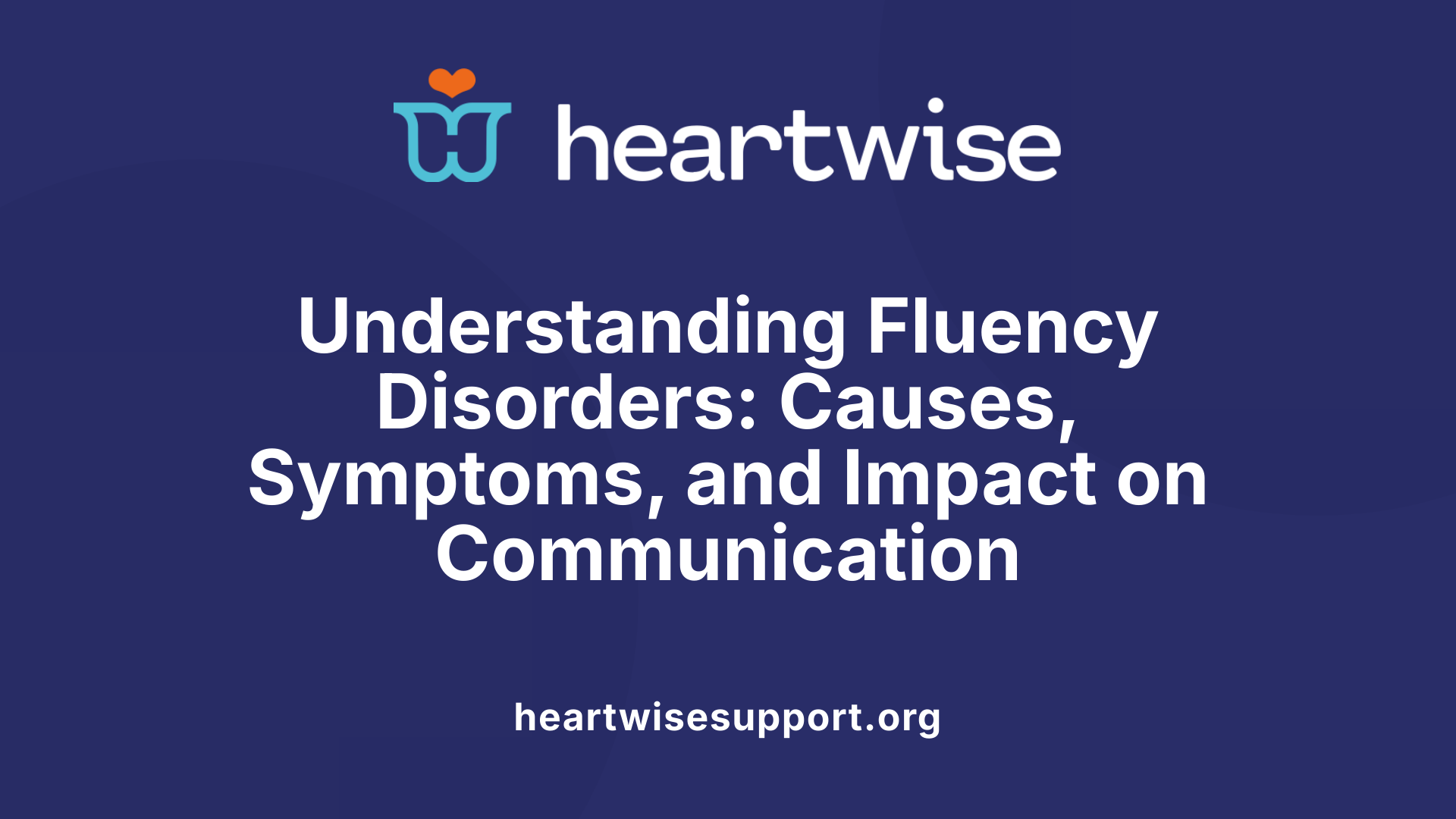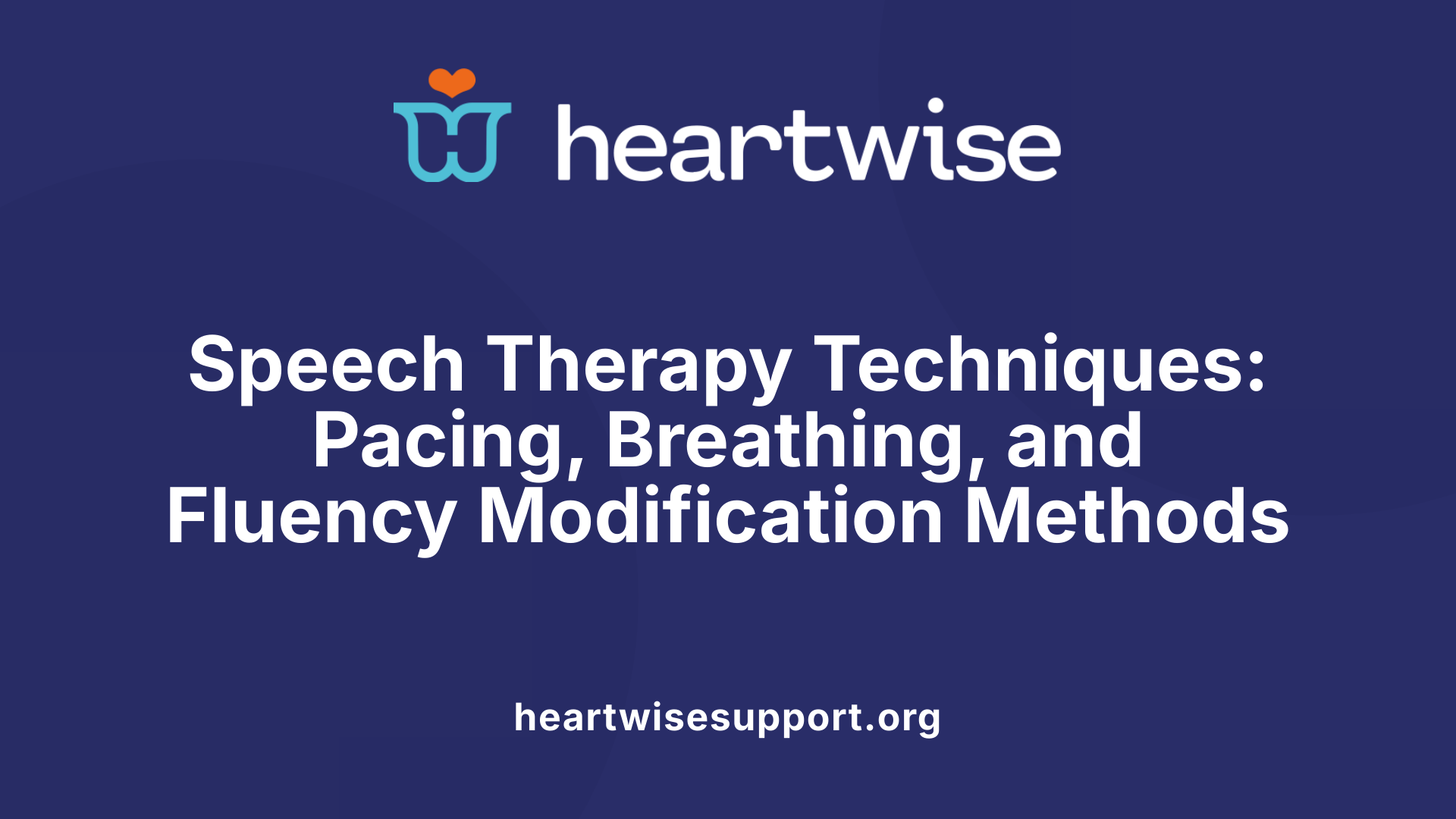Understanding Fluency and Its Disruptions
Fluency in speech refers to the smooth, effortless flow of communication, encompassing rate, continuity, and rhythm. While all speakers experience some disfluencies naturally, persistent interruptions such as stuttering and cluttering can significantly hinder effective communication. These fluency disorders not only affect speech clarity but also impact emotional well-being and social participation. This article explores the nature of fluency disorders, their assessment, and the vital role of speech therapy in managing and improving speech fluency and speech rate.
Overview of Fluency Disorders and Their Impact on Speech

What are fluency disorders and how do they impact speech?
Fluency refers to the smoothness and flow of speech, encompassing how sounds, syllables, words, and phrases connect during communication. When speech is disrupted by frequent repetitions, prolongations, or pauses, it may indicate a fluency disorder.
Fluency disorders mainly include stuttering and cluttering. Stuttering typically begins in childhood and is characterized by involuntary repetitions of sounds or words, prolonged sounds, and blocking sounds or syllables. It can be influenced by genetic factors, neurological differences, and emotional responses such as frustration or feeling rushed. Recovery rates for children are quite high, estimated around 88-91%.
Cluttering involves a rapid, irregular speech pattern, often with excessive disfluencies, slurred words, and occasional omissions, which can significantly impact clarity and intelligibility. It usually appears later than childhood and may be associated with other developmental or neurological conditions like learning disabilities or autism.
The effects of fluency disorders extend beyond mere speech disruptions. They can interfere with effective communication, leading to misunderstandings and social withdrawal. Individuals may experience lowered confidence, frustration, or anxiety about speaking, which can impact personal relationships, academic performance, and professional opportunities. Overall, managing fluency disorders through speech therapy and behavioral techniques aims to reduce these barriers, improve communication confidence, and enhance emotional well-being.
Symptoms, Causes, and Treatment of Fluency Disorders

What are the symptoms, causes, and treatment options for fluency disorders?
Fluency disorders, such as stuttering and cluttering, interfere with the smooth and natural flow of speech. People affected by these disorders often show symptoms like repetitions of sounds or words, prolongations of sounds, pauses, rapid or irregular speech rate, and excessive disfluencies like fillers ('um', 'uh'). Some may also experience behaviors such as eye blinking, foot tapping, or facial tension during speech.
The causes of fluency disorders are not fully understood, but factors like genetic predisposition and neurological differences play significant roles. Family history is often observed in individuals with stuttering, and neurological studies suggest differences in brain activity related to speech production. Environmental factors and emotional states, such as feeling rushed or frustrated, can trigger or exacerbate symptoms.
Assessment by a speech-language pathologist is essential for diagnosing fluency disorders. These professionals measure speech rate, analyze disfluency types and severity, and observe emotional reactions during speech tasks. The goal is to understand the impact on communication effectiveness and emotional well-being.
Treatment primarily involves speech therapy tailored to individual needs. Techniques include slowing speech rate, improving breath control, and employing specific speech modification strategies like phonetic shaping and easy initiation of speech. For managing psychological effects, counseling and support groups can be beneficial.
Behavioral strategies such as practicing controlled speech rates, using electronic devices, and cognitive-behavioral therapy aim to reduce anxiety and negative reactions associated with stuttering and cluttering. Early intervention, especially for children, is crucial for developing effective communication skills, reducing frustration, and preventing secondary social or emotional issues.
Overall, a combination of speech therapy, psychological support, and family involvement offers the best chance for improving fluency and enhancing quality of life for those with fluency disorders.
| Aspect | Details | Additional Notes |
|---|---|---|
| Symptoms | Repetitions, prolongations, blocks, irregular speech patterns | Includes physical behaviors like eye blinking |
| Causes | Genetic, neurological, emotional, environmental factors | Brain differences observed in studies |
| Assessment Methods | Speech rate analysis, severity tests, emotional screening | Performed by trained speech-language pathologists |
| Treatment Approaches | Speech modification, counseling, behavioral techniques | Can include electronic devices and CBT |
Speech Therapy Approaches for Enhancing Fluency and Speech Rate

How do speech therapy approaches help improve fluency and speech rate?
Speech therapy employs a variety of techniques tailored to individual needs to help individuals speak more fluently and at an appropriate rate. These approaches include behavioral, physiological, and cognitive strategies that work together to modify speech patterns.
Fluency shaping techniques focus on controlling speech timing and effort. For example, slowing down speech rate is achieved through deliberate methods like stretching syllables, using prolonged vowel sounds, and practicing easy initiation of phrases. These methods help produce more continuous speech, reduce disfluencies, and make speech easier to understand.
Fluency modification strategies such as cancellation and pull-out techniques are used during moments of stuttering. These techniques help speakers gain control by reducing tension and encouraging relaxed speech production, thus enhancing overall fluency.
Furthermore, therapy often targets emotional and psychological factors contributing to fluency difficulties. Cognitive-behavioral therapy and support groups aim to build confidence, reduce anxiety, and address negative reactions associated with stuttering.
Personalized treatment plans integrating these methods are most effective. They combine behavioral adjustments, physiological relaxation, and cognitive strategies to help individuals speak more fluently and comfortably.
Early intervention can significantly improve outcomes, emphasizing the importance of timely assessment and therapy. A multidisciplinary approach involving speech-language pathologists, psychologists, and educators ensures that all aspects of a person's communication and emotional health are supported.
In summary, speech therapy leverages a combination of techniques targeting speech mechanics, emotional well-being, and speech rate adjustment, fostering more fluent and confident communication.
More info: Speech therapy techniques for fluency
| Technique | Purpose | Usually Used With | Additional Notes |
|---|---|---|---|
| Speech slowing | Reduce speech rate to improve fluency | All ages, especially children and adults | Includes prolonged vowels and pausing techniques |
| Easy onset and gentle contacts | Minimize tension during speech production | Children learning to speak, stutterers | Focus on relaxed, smooth movements of speech organs |
| Fluency shaping exercises | Create more fluent speech production | Persistent fluency disorder cases | Incorporates slow speech, controlled breathing |
| Stuttering modification | Manage and reduce severity during stuttering episodes | Adults and children who stutter | Emphasizes acceptance and control techniques |
| Cognitive-behavioral approaches | Address emotional impacts of disfluency | All age groups | Builds self-confidence, reduces anxiety |
Final thoughts
Personalized therapy that combines these strategies effectively helps improve speech fluency and rate. Regular practice, professional guidance, and support systems are vital for achieving lasting progress.
Techniques Used in Speech Therapy to Enhance Fluency

What techniques are used in speech therapy to enhance fluency?
Speech therapy employs a variety of techniques aimed at helping individuals produce fluent speech more easily and confidently. One fundamental approach involves pacing strategies, slowing the rate of speech, and controlled breathing. These methods help establish a more natural rhythm and reduce the physical tension often associated with disfluencies.
Pacing strategies include slowing down speech, practicing deliberate articulation, and incorporating pauses to give the speaker time to plan upcoming words. Controlled breathing, especially diaphragmatic breathing, is used to manage airflow and reduce stress during speaking.
Specific fluency shaping techniques are also central. These include prolonging vowels to stretch syllables, which helps smooth speech and control rate. Light contact on consonants and easy onsets—initiating sounds gently—minimize physical struggle with speech sounds. Practicing these methods helps reduce tension and prevents stuttering episodes.
Another essential category involves fluency modification methods such as cancellations and pullouts. Cancellations involve pausing after a stuttered moment, then slowly continuing with more control. Pullouts are used during a disfluency, where the speaker gently eases out of the block or prolongation into smoother speech.
Tools like metronomes and rhythm-based interventions support these techniques by providing consistent timing cues, helping speakers maintain a steady pace. Using visual and auditory feedback, such as recordings or computer programs, enables self-monitoring and incremental improvements.
Combining these strategies allows for a comprehensive approach to improving overall fluency. While each technique addresses different aspects of speech production, together they help individuals speak more fluently, build confidence, and communicate more effectively in daily life.
Fluency Shaping Techniques and Their Goals
What are fluency shaping techniques and their goals?
Fluency shaping techniques are specific speech therapy strategies designed to help individuals speak more smoothly and fluently. These methods focus on altering speech patterns to reduce disfluencies such as repetitions, prolongations, and blocks.
Common techniques include slowing the speech rate, controlling breathing, prolonging vowels, initiating speech easily, and applying light contacts on consonant sounds. For example, speakers may use deliberate, slow syllable production to foster a sense of control and ease.
The main goal of these techniques is to replace behaviors like stuttering with more automatic, effortless speech. This reduces speech interruptions and helps individuals speak with greater confidence. It also aims to minimize physical tension and effort involved in speech, promoting more natural communication.
By practicing these strategies, people can achieve steadier speech flow, which enhances their overall communication effectiveness. Fluency shaping not only reduces the occurrence of stuttering but also fosters emotional comfort by decreasing anxiety associated with speech production.
Overall, the objective is for individuals to produce speech that is fluent, less effortful, and natural-sounding, helping them participate fully in social, educational, and professional settings.
Modifying Speech Rate and Rhythm in Therapy
How can speech therapy modify speech rate and rhythm to improve fluency?
Speech therapy employs various techniques to adjust the speed and flow of speech, helping individuals achieve smoother, more confident communication. One fundamental approach is slowing speech, where individuals practice speaking at a deliberate, controlled pace. This often involves elongating syllables, which reduces the pressure to speak quickly and allows for better articulation.
Deliberate pacing and rhythmic control are further enhanced through rhythmical interventions. For example, therapists may introduce rhythmic gestures or use physical cues like tapping to establish a steady tempo, encouraging the speaker to synchronize their speech with external beats. This process, known as entrainment, engages sensorimotor circuits that are essential in coordinating speech movements.
The use of rhythmic stimuli, such as metronomic beats or syllabic isochrony (equal timing between syllables), can significantly aid in neural synchronization. These cues help the brain and speech muscles work together more effectively, establishing a consistent rhythm that supports fluent speech production.
Research indicates that such rhythmic techniques not only improve speech flow but also help reorganize neural networks involved in language and motor control. They are particularly beneficial for individuals with speech fluency challenges, including stuttering, aphasia, or neurological conditions like Parkinson’s disease.
Overall, the goal of these rate and rhythm modifications in therapy is to enhance speech fluency, boost confidence, and improve social and communicative interactions. By fostering a rhythmic speech pattern and slowing speaking rate, individuals are more likely to communicate effectively and comfortably, with lasting benefits extending beyond therapy sessions.
Educational Strategies for Practicing Effective Speaking Rates
What educational strategies can help individuals practice effective speaking rates?
Promoting effective speaking rates through education involves several practical methods. One essential approach is structured speech practice, where individuals engage in deliberate rehearsals focusing on pacing. Techniques like pacing tapes or metronomes can help speakers internalize a steady tempo, reducing rushing or excessive hesitation.
Activities such as delivering speeches, participating in group discussions, storytelling, and role-playing exercises provide real-world practice. These activities encourage speakers to monitor their rate intentionally and adapt it based on context, audience, and purpose. Encouraging students to organize their ideas clearly, incorporate vocal variety, and use natural gestures enhances communication clarity.
Visual aids like timers or word-per-minute counters can provide immediate feedback on speech rate, helping learners self-correct. Peer feedback also plays a role—listening to recordings of their own speech or others’ offers valuable insights and encouragement.
Creating a supportive environment, including modeling effective speech, using positive reinforcement, and fostering peer evaluations, helps build confidence. Additionally, teaching speakers to be aware of their audience and practice in settings that simulate real scenarios enhances adaptability.
Overall, combining these strategies helps individuals develop a natural, comfortable, and effective speaking rhythm suited for diverse communication settings.
Research on Speech Rate Modification and Fluency Improvement
What are the research findings on how speech rate modification impacts fluency and stuttering?
Numerous studies have demonstrated that adjusting the speed of speech can have a positive effect on fluency, especially for individuals who stutter. Slowing down speech rate helps reduce the frequency of disfluencies, making speech sound smoother and less laborious. When speakers intentionally reduce their speaking pace, they often experience fewer interruptions, such as repetitions and prolongations, leading to a more natural flow.
Techniques like pacing speech with a metronome, using pacing boards, or practicing deliberate slow speech have been effective in clinical settings. These methods not only decrease the number of disfluencies but also help individuals develop a more controlled and less stressful speech pattern. Research indicates that by maintaining a slower rate, speakers can gain greater control over their speech, minimizing frustration and reinforcing positive communication experiences.
Furthermore, models that incorporate speech rate regulation—such as modeling slow speech during therapy—have been shown to influence how quickly individuals adopt slower speaking patterns. This consistent practice can lead to sustained fluency improvements. Overall, controlling the speech rate emerges as a vital element of therapy, providing both behavioral and neural benefits that support easier and more confident speaking.
How does adjusting speech rate benefit neural and behavioral aspects?
On a neural level, slowed speech has been associated with increased activity in brain regions responsible for speech planning and production, suggesting enhanced coordination and timing. Behaviorally, individuals who practice pacing techniques often display increased confidence and decreased secondary behaviors like eye blinking or foot tapping.
In summary, research robustly supports that modifications in speech rate are a practical and effective way to improve fluency and manage stuttering. By integrating rate control strategies into speech therapy, clinicians can facilitate both immediate and long-term gains in communication ability.
| Study/Research Source | Main Finding | Impact on Therapy | Additional Notes |
|---|---|---|---|
| Research A | Slower speech reduces disfluencies in stutterers | Enhances fluency | Includes paced reading exercises |
| Study B | Voice pacing techniques improve speech smoothness | Decreases effortful speech | Recommends modeling and practice |
| Investigation C | Neural activity increases with rate control | Supports neural adaptation | Uses neuroimaging methods |
This evidence encourages clinicians to incorporate speech rate techniques as part of comprehensive fluency therapy, helping individuals speak more fluently, confidently, and comfortably.
Implementing and Supporting Fluency in Daily Life
What is the slow rate fluency strategy and how is it implemented?
The slow rate fluency strategy, often called the stretched syllable technique, is a practical approach used to enhance speech fluency. It involves deliberately speaking each syllable slowly and evenly, typically aiming for a speech rate of about 40 to 60 syllables per minute. This pace is much slower than typical conversational speech, which averages around 150 words per minute.
Implementation starts with breaking down words into individual syllables. Each syllable is then consciously stretched to last about two seconds. For example, the word "comfortable" might be spoken as "com-for-ta-ble," with each part elongated. As proficiency develops, speakers gradually increase their speaking rate towards a more natural rhythm while maintaining the clarity and evenness of each syllable.
Controlled breathing is a crucial component of this technique. Speakers often use diaphragmatic breathing to support steady airflow, which helps reduce tension and prevents rushing. Light articulatory contacts—gentle touches of the tongue or lips on sounds—and easy onset of sounds help facilitate smoother transitions between syllables.
The main goal of the slow rate strategy is to regulate speech flow, lowering tension and minimizing disfluencies caused by speaking too quickly. When combined with other methods, such as easy initiation of speech and relaxation exercises, this technique can significantly improve overall fluency, boost confidence, and reduce anxiety associated with speaking.
Practicing this technique regularly, whether through therapy sessions, recordings, or daily conversation exercises, creates sustainable habits that promote fluent speech. Over time, individuals learn to balance a slower, more controlled speech rate with natural rhythm, enabling clearer and more effective communication in their daily lives.
Fostering Effective and Confident Communication
Effective speech therapy for fluency and speech rate aims to develop personalized strategies that enhance clarity, reduce disfluencies, and build confidence. Techniques like slowing speech, managing rhythm, and practicing deliberate pacing support individuals in achieving more natural and effortless speech. Continual practice, combined with professional guidance and supportive learning environments, empowers speakers to communicate effectively across different situations, improving social participation and emotional well-being. Overall, fluency therapy is a dynamic process that adapts to individual needs and fosters lasting improvements in communication.
References
- Stuttering, Cluttering, and Fluency - ASHA
- Speech Therapy for Stuttering and Fluency Disorders
- Improving Literacy Rates Through Speech Therapy - Integrity, Inc.
- What is Fluency Shaping and How It Helps Reduce Stuttering
- Understanding Fluency Shaping Techniques in Speech Therapy
- Speaking Rate - Tools for Clear Speech
- 11 Ways to Increase Your Child's Speech Fluency











